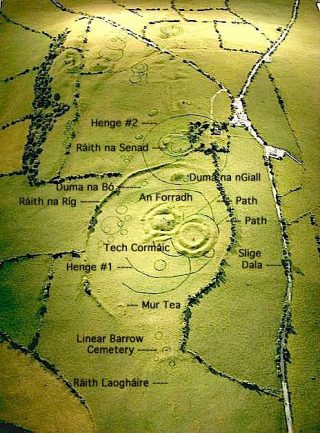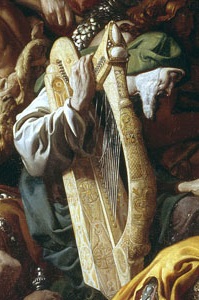L’arpa di Tara è per Thomas Moore il simbolo dell’Irlanda, il suo cuore indomito e puro.
Ma “The harp that once through Tara’s Hall” è un lamento disperato poichè ai suoi tempi il canto dell’arpa tace, e gli Irlandesi non anelano più alla libertà. Il canto è la controparte (alla rovescia) di un’altra poesia di Moore -molto più popolare anche ai nostri tempi- e bellicosa The last ministrel.
Nel 1700 l’arpa divenne il simbolo della rivoluzione irlandese quando venne scelta come emblema sui vessilli dalla “Society of United Irishmen”. Dopo il fallimento della ribellione l’arpa acquistò anche nella letteratura e nella poesia un simbolo d’identità associato all’Irlanda, ruolo rimasto incontrastato anche nei tempi moderni.

L’arpa portatile di Thomas Moore, Royal Irish Academy, Dawson Street, Dublino
L’arpa gli venne donata nel 1821 da John Egan, produttore di arpe di Dublino (anche all’epoca gli uomini famosi facevano da sponsor per la pubblicità). E tuttavia Moore preferì il pianoforte come strumento d’eccellenza per la partitura delle sue irish Melodies.
[English translation]
Tara’s harp is for Thomas Moore the symbol of Ireland, its indomitable and pure heart.
But this poem (The harp that once through Tara’s Hall) is a desperate lament because in his time the singing of the harp is silent, and the Irish no longer yearn for freedom. This song is the counterpart (upside down) of another Moore poem – much more and bellicose and popular even in our times – The last ministrel
In 1700 the harp became the symbol of the Irish revolution when it was chosen as the emblem on the flags by the ““Society of United Irishmen“.
After the failure of the rebellion, the harp acquired an identity symbol too, associated with Ireland in literature and poetry, a role that has remained unchallenged even in modern times.

The harp that once, through Tara’s halls,
The soul of music shed,
Now hangs as mute on Tara’s walls

The harp was given to him in 1821 by John Egan, a Dublin harp maker (famous men also sponsored advertising at the time). And yet Moore also preferred the piano as an instrument of excellence.
I
The harp that once, through Tara’s halls (1),
The soul of music shed,
Now hangs as mute on Tara’s walls
As if that soul (2) were fled.—
So sleeps the pride of former days,
So glory’s thrill is o’er,
And hearts, that once beat high for praise,
Now feel that pulse no more!
II
No more to chiefs (3) and ladies bright
The harp of Tara swells;
The chord, alone, that breaks at night,
Its tale of ruin tells (4).
Thus Freedom now so seldom wakes,
The only throb she gives,
Is when some heart indignant breaks,
To shew that still she lives!
I
L’arpa che un tempo nelle sale di Tara,
la musica dell’anima diffondeva
ora pende muta nella ruinosa Tara
come se quell’anima fosse fuggita-
così dorme l’orgoglio dei vecchi tempi
così l’ebbrezza della gloria si è sopita,
e i cuori, che un tempo esultavano nella gloria,
oggi non pulsano più!
II
Non più per i guerrieri e le belle dame
l’arpa di Tara risuonerà;
la corda che, sola, vibra nella sera,
la sua storia di rovina narra.
Così Libertà ora raramente si sveglia;
il suo unico singulto
è quando un cuore sdegnato freme,
per dimostrare che essa è ancora viva.
NOTES
1) the legendary palace of Tara, -in gaelic Tehmair (Mother earth) – seat of the King of the Kings of Ireland (Ard-Ris). On the hill of Tara is placed the monolith called Stone of Destiny, donated by the gods to reveal to the people the future king of the island. According to the legends Tara is one of the gates to the Otherworld, and hides the mound of the Tuatha de Danaan, the ancient gods, according to the myths of the Irish Invasions, “the people of Dana” came “from the lands to the north of the world, descended on the Earth from nowhere, wrapped in clouds, and disappeared into nothingness. ” The palace was also home to the Fianna, mythical warrior protectors of Ireland (called the Knights of Destiny) and home to a high Druidic school. The hill is located in the Meath about forty km from Dublin and according to archaeological excavations it has been an ancient settlement since the Iron Age (formerly a Neolithic settlement), crossroads of the Island: The Moud of the Hostages, built between 3350 and the 2800 a. C., the Enclosure of the Kings, the Cormac’s House and the Royal Seat. On the hill there is also a Fairy tree from whose branches visitors hang strips of cloth for health and luck, on its branches the crows, emanation of the goddess Morrigan.
2) Ever since the harp stopped playing, the spirit of Ireland has never manifested itself, the ruthless English repression has weakened the hearts of the Irish.
3) literally leaders, commanders but in the context are the Fianna, the legendary protector warriors of Ireland.
4) Moore loved Irish music and wanted to preserve it by popularizing it among the British.
NOTE e Traduzione italiana Cattia Salto
1) la leggendaria reggia di Tara, -Tehmair (terra madre)- sede del Re dei Re d’Irlanda (Ard-Ris). Sulla collina di Tara è collocato il monolite detto Pietra del Destino, donata dagli dei per rivelare al popolo il futuro re dell’Isola. Secondo le leggende Tara è una delle porte per l’Oltremondo, e nasconde il tumulo dei Tuatha de Danaan, gli antichi dei, secondo i Miti delle Invasioni irlandesi, “il popolo di Dana” proveniva “dalle terre a nord del mondo, scese sulla Terra dal nulla, avvolto dalle nuvole, e scomparve nel nulla”. La reggia fu anche dimora dei Feniani, mitici guerrieri protettori dell’Irlanda (detti i Cavalieri del Destino) e sede di un’alta scuola druidica. La collina si trova nel Meath a una quarantina di km da Dublino e secondo gli scavi archeologici è stato un antico insediamento fin dall’età del ferro (già insediamento neolitico), crocevia dell’Isola: Il Tumulo degli Ostaggi, costruito tra il 3350 e il 2800 a. C., il Forte dei Re, la Casa di Cormac e il Seggio reale. Sulla collina si erge anche un albero delle Fate ai cui rami i visitatori appendono strisce di stoffa per ottenere salute e fortuna, sui suoi rami sono appollaiati i corvi, emanazione della dea Morrigan.
2) da quando l’arpa ha smesso di suonare, lo spirito dell’Irlanda non si manifesta più, la spietata repressione inglese ha fiaccato i cuori degli Irlandesi.
3) letteralmente capi, comandanti ma nel contesto sono i feniani, i mitici guerrieri protettori dell’Irlanda.
4) Moore amava la musica irlandese e volle preservarla popolarizzandola tra gli inglesi.
LINK
http://ontanomagico.altervista.org/arpa-celtica.html
https://digital.nls.uk/broadsides/view/?id=16436
https://thesession.org/tunes/7855
https://songoftheisles.com/2013/05/18/the-harp-that-once-through-taras-halls/
http://www.fresnostate.edu/folklore/ballads/FSWB320C.html
https://irishstudies.sunygeneseoenglish.org/sinn-fein-harp-analysis/
https://www.euromanticism.org/thomas-moores-harp/
http://www.schliemann-carter.it/News/2009.04.14%20Scoperto%20circolo%20a%20Tara.html
http://www.megalithicireland.com/Hill%20of%20Tara.htm
